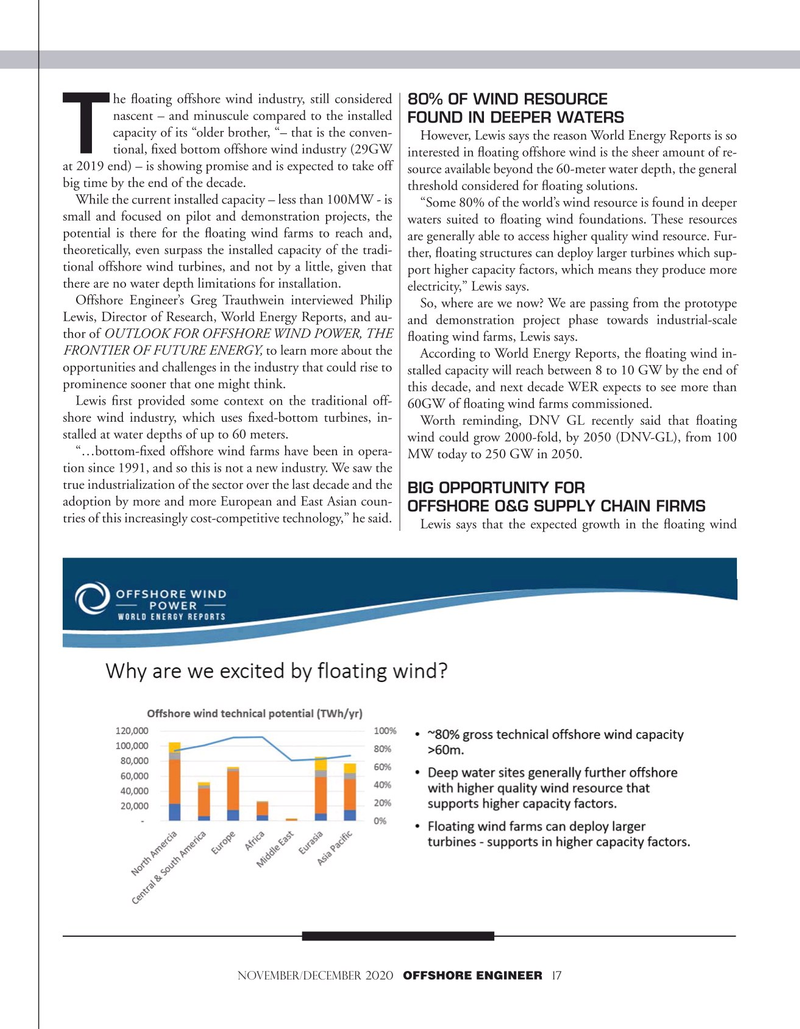
Page 17: of Offshore Engineer Magazine (Nov/Dec 2020)
Read this page in Pdf, Flash or Html5 edition of Nov/Dec 2020 Offshore Engineer Magazine
he ?oating offshore wind industry, still considered 80% OF WIND RESOURCE nascent – and minuscule compared to the installed
FOUND IN DEEPER WATERS capacity of its “older brother, “– that is the conven-
However, Lewis says the reason World Energy Reports is so
T tional, ?xed bottom offshore wind industry (29GW interested in ?oating offshore wind is the sheer amount of re- at 2019 end) – is showing promise and is expected to take off source available beyond the 60-meter water depth, the general big time by the end of the decade.
threshold considered for ?oating solutions.
While the current installed capacity – less than 100MW - is “Some 80% of the world’s wind resource is found in deeper small and focused on pilot and demonstration projects, the waters suited to ?oating wind foundations. These resources potential is there for the ?oating wind farms to reach and, are generally able to access higher quality wind resource. Fur- theoretically, even surpass the installed capacity of the tradi- ther, ?oating structures can deploy larger turbines which sup- tional offshore wind turbines, and not by a little, given that port higher capacity factors, which means they produce more there are no water depth limitations for installation.
electricity,” Lewis says.
Offshore Engineer’s Greg Trauthwein interviewed Philip
So, where are we now? We are passing from the prototype
Lewis, Director of Research, World Energy Reports, and au- and demonstration project phase towards industrial-scale thor of OUTLOOK FOR OFFSHORE WIND POWER, THE ?oating wind farms, Lewis says.
FRONTIER OF FUTURE ENERGY, to learn more about the
According to World Energy Reports, the ?oating wind in- opportunities and challenges in the industry that could rise to stalled capacity will reach between 8 to 10 GW by the end of prominence sooner that one might think.
this decade, and next decade WER expects to see more than
Lewis ?rst provided some context on the traditional off- 60GW of ?oating wind farms commissioned.
shore wind industry, which uses ?xed-bottom turbines, in-
Worth reminding, DNV GL recently said that ?oating stalled at water depths of up to 60 meters.
wind could grow 2000-fold, by 2050 (DNV-GL), from 100 “…bottom-?xed offshore wind farms have been in opera-
MW today to 250 GW in 2050.
tion since 1991, and so this is not a new industry. We saw the true industrialization of the sector over the last decade and the
BIG OPPORTUNITY FOR adoption by more and more European and East Asian coun-
OFFSHORE O&G SUPPLY CHAIN FIRMS tries of this increasingly cost-competitive technology,” he said.
Lewis says that the expected growth in the ?oating wind
NOVEMBER/DECEMBER 2020 OFFSHORE ENGINEER 17

 16
16

 18
18